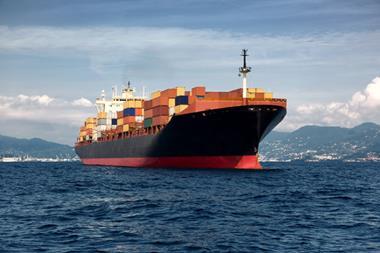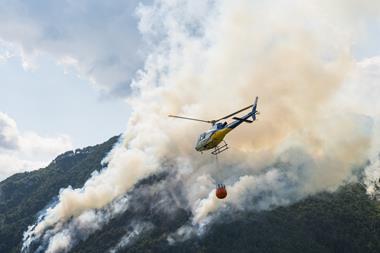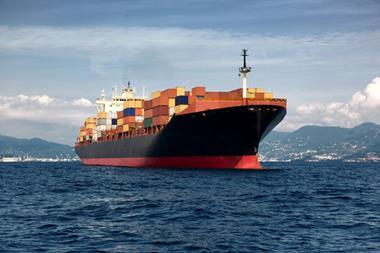The risk from undeclared or misdeclared hazardous cargo has grown substantially
An increase in the number of cargo-related ship fires is concerning cargo insurers as the latest mega-cargo ships pose a greater risk for those operating on vessels, cargo interests and insurers alike.
According to a number of insurance industry executives the adjacency of cargo on larger ships means that the risk from undeclared or misdeclared hazardous cargo has substantially increased, while the firefighting capability on the vessels is the same today as it was in the 1980s.
TT Club’s risk management director Peregrine Storrs-Fox told Insurance Times, “Given how long these incidents take to be finalised – mostly through litigation – it is impossible to provide costs for recent years. Remember [the] MSC Flaminia [fire] occurred in July 2012, the liability judgment was handed down in September 2018 and the case has yet to be finally settled. For that, we understand that the full direct costs are between $300m and $500m.”
The International Union of Marine Insurers (IUMI), in its 2019 analysis on the marine insurance market believes that claims as a result of accidents in the latter part of 2018 and early 2019 will push the claims total.
“Major hull & machinery losses were unusually few during the period 2016–2018, but the first quarter of 2019 was characterised by a renewed impact of major losses and especially a high number of fires on container vessels,” said the report.
Mitigating accidents
An increase in the numbers of cargo fires over the course of this year has seen an average of one major fire every month, according to cargo insurer TT Club, which has advocated for industry changes that would allow shipping lines to know what was in a container, helping to mitigate accidents.
Mark Smith, Loss Prevention Executive, North P&I Club which insures the hull and machinery on a vessel agreed that fires on board vessels was becoming more prevalent, with over 30 fires reported to the club in the first six months of this year.

In many cargo fires the cause is often misdeclared or undeclared cargo. Misdeclared cargoes, where hazardous freight is categorised incorrectly through error or ignorance; or undeclared cargo where the shipper deliberately fails to declare a hazardous cargo to reduce the freight costs.
In either case the containers would have no markings to tell crew what is inside, which means the container may not be stowed appropriately and, in the event of a fire, could substantially increase the risk to crew, other freight shipments, the integrity of the vessel and the surrounding environment.
Hazardous cargo
Experts believe that around 10% of the cargo aboard a container vessel is declared as hazardous, and this is a mixture of different dangerous goods. This cargo can be stowed on deck away from heat sources and where, in the event of a fire, crew can gain access to deal with it.
Misdeclared cargo can be stored in a hold where, if a fire breaks out crew cannot deal with it and surrounding cargo can feed the flames as the heat intensifies.
Most cases are not generally reported, while others, such as the Maersk Honam fire of March 2018, are widely reported. This year there have been at least two instances of fires caused by charcoal cargoes, which many shippers see as a benign cargo, though in some instances charcoal, for barbeques can have petrol added to it.
Other fires are started by cargo that is known to be extremely hazardous, as was the case of the explosion and fire in Thailand’s Laem Chabang port, which saw a quayside explosion attributed to calcium hypochlorite.
Used in swimming pools and other places for water purification, calcium hypochlorite burns and explodes quite violently when subjected to heat and the danger with this chemical is it produces its own oxygen, further intensifying and sustaining the fire.
Richard Janssen, the managing director at the Dutch marine salvage firm Smit, said, “A part of a cargo or a combination of cargoes may create an accelerated effect on the fire, the trouble with container [ship] fires is that you don’t know what is where, in terms of the cargo.”
Storage risk
Heat is often a precursor for a fire, but some goods can generate their own heat. Once fires take hold then they can burn with high intensity, up to around 1,000 degrees centigrade, hot enough to melt steel, according to Storrs-Fox.
And Janssen confirmed that the fire on Maersk Honam was hot enough to melt the lashing bridges on the vessel.
”The variety of cargo onboard is increasing, there are new chemicals etc, but it’s not all to do with dangerous goods, it’s also to do with the adjacency risk, where cargo is stored next to hazardous cargo, and that is a factor of the size of ships.
”The MSC Flaminia 2012 was 6,700 TEU (twenty-foot equivalent units), while Maersk Honam [which saw five crew killed in a blaze in March 2018], is 15,800 TEU, so there is a problem of aggregation, which increases for cargo near to improperly declared shipments putting that cargo at greater risk.”
As the ships have increased in size, the risk of fire has also increased, but according to former container ship captain Amerinder Singh Brar, now a working for London Offshore Consultants, modern container ships are built to the same fire regulations as vessels built in 1983, the regulations have not changed. “Would you buy a car built to 1983 regulations?” He asked.
Reports made available to the IMO on an annual basis on violations of cargo regulations, show few containers are inspected, around 75,000/year out of 180 million cargo movements, mainly conducted in the US. Their findings are uncomfortable but not clear enough to give rise to direct action.
A maritime industry initiative called the Cargo Incident Notification System (CINS) also carried out around 500 inspections, around 60% of these had deficiencies, but they were not necessarily a fire risk, as other discrepancies were found including weight specifications and packing failures.
Mark Smith told Insurance Times that North P&I tried to educate its clients to spot misdeclared cargo and how to vet new customers.
However, Smith concluded, “Fires in cargo holds especially can damage a lot of adjacent cargo. Water and CO2 used to extinguish the fire can also cause damage as well as tainting adjacent cargo.
”Many of the large carriers have vessel sharing agreements so more than one carrier may hold container slots on one vessel at any time. There is also a chance that all cargo is delayed by the salvage operations and trans-shipment of containers.
Pass notes - Why is there a greater risk from container shipping?
Container cargo fires are increasing in number
Bigger ships carry a greater risk of cargo fires
Few containers are inspected for what is in the box
Larger ships carry more cargo and that means damage to adjacent cargo is increased raising the cost of each fire incident
Firefighting equipment on board vessels is insufficient to deal with the intensity of cargo fires as it spreads through a vessel’s cargo hold
Fire regulations on board ships are same today as they were in 1983 even though the container shipping industry has changed substantially in the intervening period
Source













































No comments yet